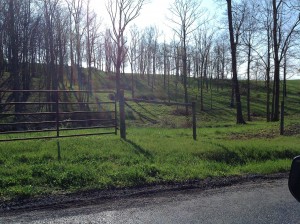When it comes to historical research, it’s all too easy to follow one thread, then another, until progress slows to the pace of a journey by horse and wagon in the 18th century.
Currently, in my studies of Scots immigrants to Ohio, I’m on the trail of pre-canal, pre-railroad travel. Via interlibrary loan, I’ve checked out a copy of Margaret Van Horn Dwight’s diary, published under the title “A Journey to Ohio in 1810.” A delightful account of an arduous trip delayed again and again, due to weather, flooding rivers, and a horse too exhausted to go on. Margaret and her companions were traveling from New Haven, Connecticut to Warren, Ohio. Below is a sample entry:“Thursday night — Allegany (sic) Mtn Nov– 16 [1810]
We have had a warm & pleasant day till towards night, when it began to rain, as it has done every day for a fortnight — we are now at a tavern half a mile from the top of the Allegany Mt- this Mountain is 14 miles over- At the highest part of it is a most beautiful prospect of mountains- 5 or 6 ridges one after the other- … I pick’d a sprig of ivy from the top, which … came from the very backbone of America, as they all tell us — We have walk’d a great deal to day, & indeed we are oblig’d to every day, for the whole country seems one continued mtn…”
Because of the steep terrain, to spare the horse, Margaret and her companions climbed the mountains on foot, walking next to the wagon.
Another route over the Allegheny Mountains started out of Baltimore, Maryland. By the end of the 1700s, this road reached well into the Northwest Territory (present-day Ohio, Illinois, Michigan and Indiana). The first leg of the route from Baltimore went to Uniontown, Pennyslvania, a road cut in the 1750s by General Braddock’s troops during the French and Indian War. The second leg, Gist’s trace, was cut by white trader Thomas Cresap and his friend the Delaware Chief Nemacolin, and stretched from explorer Gist’s plantation in Uniontown as far as the Monongahela River at present-day Brownsville, Pennsylvania.
The third leg was cut by Ebenezer Zane around 1796. Called Zane’s Trace, it was a narrow, clumsily cut path through giant trees of the Ohio wilderness. Eventually, Zane’s trace extended from present-day Wheeling, West Virginia to Maysville, Kentucky. As the trees were felled by Zane’s men, the story goes, little care was taken about the tree stumps. As a result, wagons sometimes high-centered on stumps, or got stuck between them. It’s said that Zane’s Trace is where people first used the expression “to get stumped,” as in, stuck and going nowhere.
Huh. I know the feeling. Time for me to get off my research duff and start writing.

